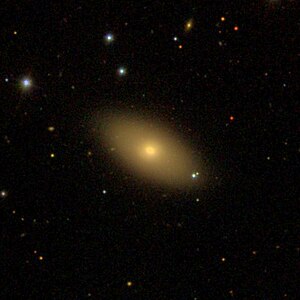NGC 5507
| Galaxy NGC 5507 |
|
|---|---|

|
|
| SDSS recording | |
| AladinLite | |
| Constellation | Virgin |
|
Position equinox : J2000.0 , epoch : J2000.0 |
|
| Right ascension | 14 h 13 m 19.8 s |
| declination | -03 ° 08 ′ 55 ″ |
| Appearance | |
| Morphological type | SB0 |
| Brightness (visual) | 12.5 mag |
| Brightness (B-band) | 13.5 likes |
| Angular expansion | 1.6 ′ × 0.9 ′ |
| Position angle | 55 ° |
| Surface brightness | 12.7 mag / arcmin² |
| Physical data | |
| Redshift | 0.006174 +/- 0.000017 |
| Radial velocity | (1851 +/- 5) km / s |
|
Stroke distance v rad / H 0 |
(81 ± 6) · 10 6 ly (24.8 ± 1.7) Mpc |
| history | |
| discovery | Wilhelm Herschel |
| Discovery date | April 15, 1787 |
| Catalog names | |
| NGC 5507 • UGCA 388 • PGC 50786 • CGCG 018-082 • MCG + 00-36-029 • 2MASX J14131987-0308558 • GC 3808, 3807 • H IV 49 • h 1758 • LDCE 1076 NED005 | |
NGC 5507 is a 12.5 mag bright, lens-shaped galaxy of the Hubble-type SB0 in the constellation Virgo on the ecliptic . It is estimated to be 81 million light years away from the Milky Way and has a diameter of around 40,000 ly. Together with NGC 5506, it forms a gravitationally bound galaxy pair.
The galaxy IC 985 is located in the same area of the sky .
The object was discovered on April 15, 1787 by Wilhelm Herschel with an 18.7-inch reflector telescope, who described it as “pB, stellar, like a star with a small bur all around”.
